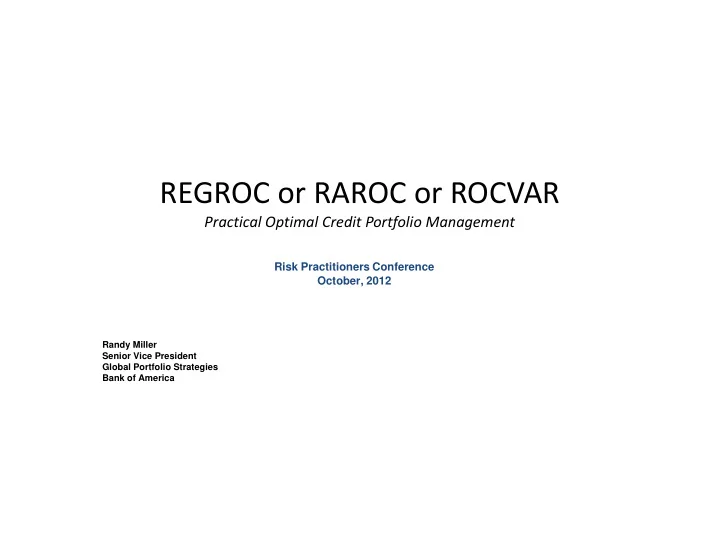

REGROC or RAROC or ROCVAR Practical Optimal Credit Portfolio Management Risk Practitioners Conference October, 2012 Randy Miller Senior Vice President Global Portfolio Strategies Bank of America
Practical Optimal Credit Portfolio Management Forming a Strategic and Tactical Partnership to Influence the Business Deliver for Manage Risk Shareholders Well Maintain a Strong Balance Sheet Opportunities Challenges • Bias for short term growth and earnings versus • Optimize for stable growth and earnings future earnings volatility • Optimal Risk Metrics • Conflicting Risk Metrics • Pressure to compromise first line of defense • More nimble first line of defense • Forward-looking risk measurement and • Rear view risk measurement and management management • Rear view migration risk • Forecast migration risk • Manage to extended rebalancing times • Limited liquidity • Coherent Optimal Business Plans • Silo Business Plans All Data is Indicative Only 2
Basel All Data is Indicative Only 3
Understand The Risk Metrics EC versus RC versus CVAR Junk Risk Metric Correlation CVAR Speculative Grade Investment Grade B2 RWA $$ RC or EC Which is Binding? IG SG Junk Ratings All Data is Indicative Only 4
Optimal Portfolio Modeling - Overview Maximize (Return ~ Accrual, RANIM, MTM, Relationship) Subject to: o Risk constraints ~ Reg Cap, Econ Cap, CVAR o Portfolio exposure growth constraints o Segment exposure growth constraints o Segment asset quality constraints Simplified version of Rockafellar and Uryasev CVAR optimization 5 All Data is Indicative Only
Optimization Model - Model Setup The Art of Optimization Constraints avoid ‘corner’ solutions Constraint setting can consider LOB views on realizable business opportunities Available model setups: • Generate efficient frontiers • Total risk-weighted asset constraint • Set freeze/decrease only segments • Customer acquisition opportunities • Pro forma asset quality constraints 6 All Data is Indicative Only
Optimization Model – Process Summary Simulation Simulated Losses Output Segment Level Exposure Level Aggregation Map Optimal Weights Revenue and Portfolio File Segment Level Other Optimizer Portfolio Characteristics Associated Relationship Segment Level Revenue/Risk Information Risk Limits Constraints Commercial, Consumer Portfolio Level, Segment Level All Data is Indicative Only 7
Practical Optimal Portfolio Opportunities Integrate forecasts with what the portfolio and the market give you over the chosen horizon $45 34% 29% 25% 21% 17% $40 14% $35 19% 18% 14% Return Mid-cycle 16% Strategic 15% $30 Full range of portfolio changes Recovery 13% 13% $25 Tactical 10% Downturn Next 12 months $20 Current 14% $15 $15 $20 $25 $30 $35 $40 $45 Risk All Data is Indicative Only 8
Optimization in Practice Convergence with Business Plans 20% 1 Balance Growth: Optimization Strategy LOB 1 10% LOB 5 LOB 2 LOB 6 LOB 7 LOB 3 LOB 8 2 0% 4 -20% -10% 0% 10% 20% LOB 10 LOB 4 LOB 9 LOB 11 -10% 3 -20% Balance Growth: LOB Strategy Optimization reductions more aggressive than LOB Optimization growth more aggressive than 3 1 growth LOB 2 LOB reductions more aggressive than Optimization growth LOB growth more aggressive than Optimization 4 All Data is Indicative Only 9
Plans & Optimization Converge - Process Two Separate Drive to Collect Plans Evaluate Plans Integrated Plan Plans Consensus • Business plan and • Collect business • Evaluate and • Understand • Business plan and optimization are plans at the most compare business business plan optimization recommending granular level plan with both and adjust converge different growth possible the tactical and optimization • Optimal and reduction strategic • Adjust business benchmark opportunities optimization plan to be more provides optimal opportunity to track progress and adjust as conditions change Iterate All Data is Indicative Only 10
Forecast Cycle Views – 1 to 3 year Horizon Downturn Mid-Cycle Baseline Consensus Recession Recovery Alternative Scenarios • Stress • Statistical • Specified • Market’s Greatest Hits • Long Run Average All Data is Indicative Only 11
Determine Strategic Enterprise Asset Allocation Depends on economic outlook. Retail 1 and Wholesale 2 cycle “swing plays” Wholesale 1 17% 21% 22% ‘Swing Play ’ Wholesale 2 14% 13% 18% Wholesale 3 10% ‘Swing Play ’ 17% Retail 1 21% 13% 14% 17% Retail 2 12% 12% Retail 3 Current Recovery Downturn 11% Retail 4 5% 10% 15% 20% 25% % of Total Balance All Data is Indicative Only 12
Reduce RWA > 5% and Improve Portfolio REGROC, RAROC, or ROCVAR Return 30 0.68 0.70 0.72 0.73 25 95% 94% 0.72 90% 88% = Efficiency (Baseline) 85% = Optimized RWA (Baseline) 20 0.60 75% 15 25 30 35 40 45 Risk All Data is Indicative Only 13
Determine highest value tactical plays Efficiency = Return/Risk Target Optimal Efficiency for 2012 is 1.1 by year -end 50 Optimal Efficiency = 1.75 – 2.5 45 40 Optimal Efficiency = 0.93 – 1.2 Return ($B) 35 Strategic Horizon Plays 30 Current Efficiency = 0.98 25 Tactical Horizon 20 15 10 15 20 25 30 35 40 Risk ($B) All Data is Indicative Only 14
Deals and Portfolio Performance Operate within Risk Appetite Standards, AQ Standards, and Limit Guardrails = Deal Enterprise = Concentration Portfolio All Data is Indicative Only 15
Looking Ahead • Counterparty • Liquidity Ratios and Interaction with Credit Risk • Full Balance Sheet Optimization All Data is Indicative Only 16
Recommend
More recommend